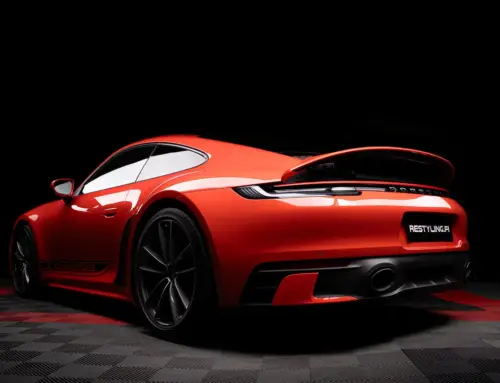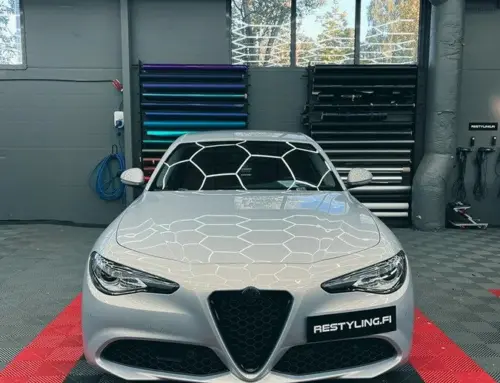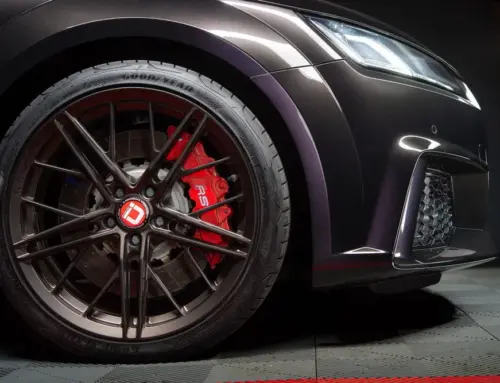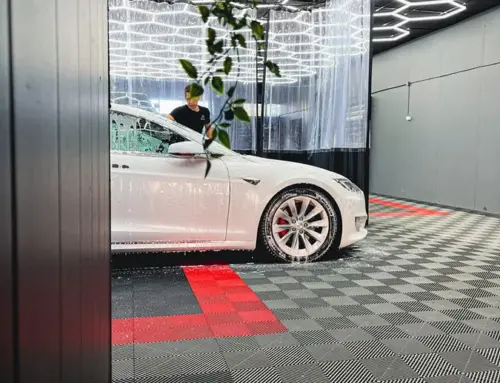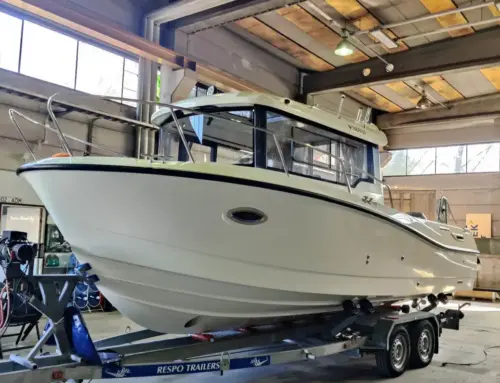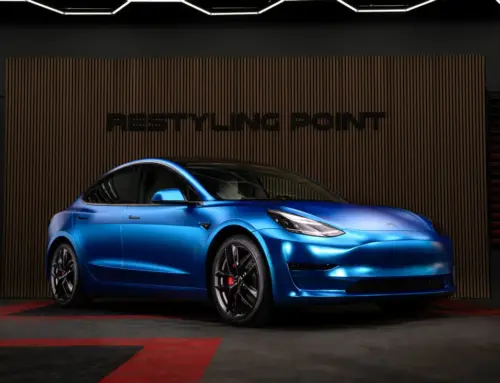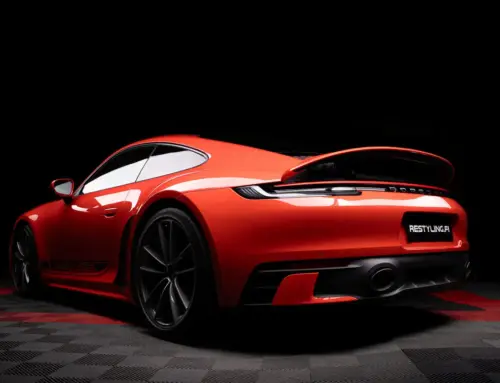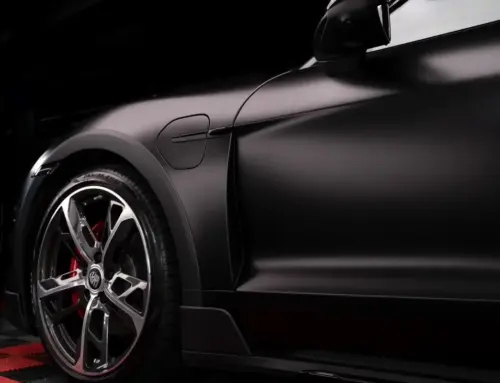- Facts about New Car
- Car as a Tool
- New Car Incoming?
- How Much PPF Protection is Worth It?
- Headlights
- Is It Worth Protecting a Used Car with PPF?
- Can You Install the Film Yourself?
- Insurance Tips
- Painting Tips
Facts about New Car
When a car is new, it doesn’t have stone chips or major scratches. However, once it leaves the dealership, its lifespan begins to shorten, and its resale value starts to decrease from the first meter onwards. Nevertheless, these damages can be avoided.
On the road, there are gravel, nails, rocks, damaging chemicals, etc. Even at a safe distance from the vehicles ahead, thousands of invisible stone chips fly, and the largest ones leave visible marks on the front and side panels, surprising us.
The reason for protecting the car with films is that stone chips and deep scratches cannot be removed by polishing alone. Only repainting is the proper solution for this. However, repainting, besides being costly, poses many risks, such as matching the same shade and the fact that the part of the car won’t be original anymore.
Throughout the automotive industry’s history, original intact vehicles and their paintwork have been valued. That’s why it’s worth keeping the original paint as it is and protecting it in the most effective way possible.
Car as a Tool
Despite this, most people inspect the car’s paintwork before purchasing it, and one of the questions asked by car dealers over the phone is often, “How many stone chips are there on the front and hood?”
There may be significant differences in paint thicknesses between car brands. It’s essential to find out the characteristics and weak points from your car brand’s forums or paint protection film installation shops.
Wherever we live, whatever car we buy, the most effective way is to pack the car onto a trailer and drive it to a wrapping shop for protection. However, this is usually not cost-effective, so a new car is often driven to the nearest installation shop for PPF or even to the other side of Finland.
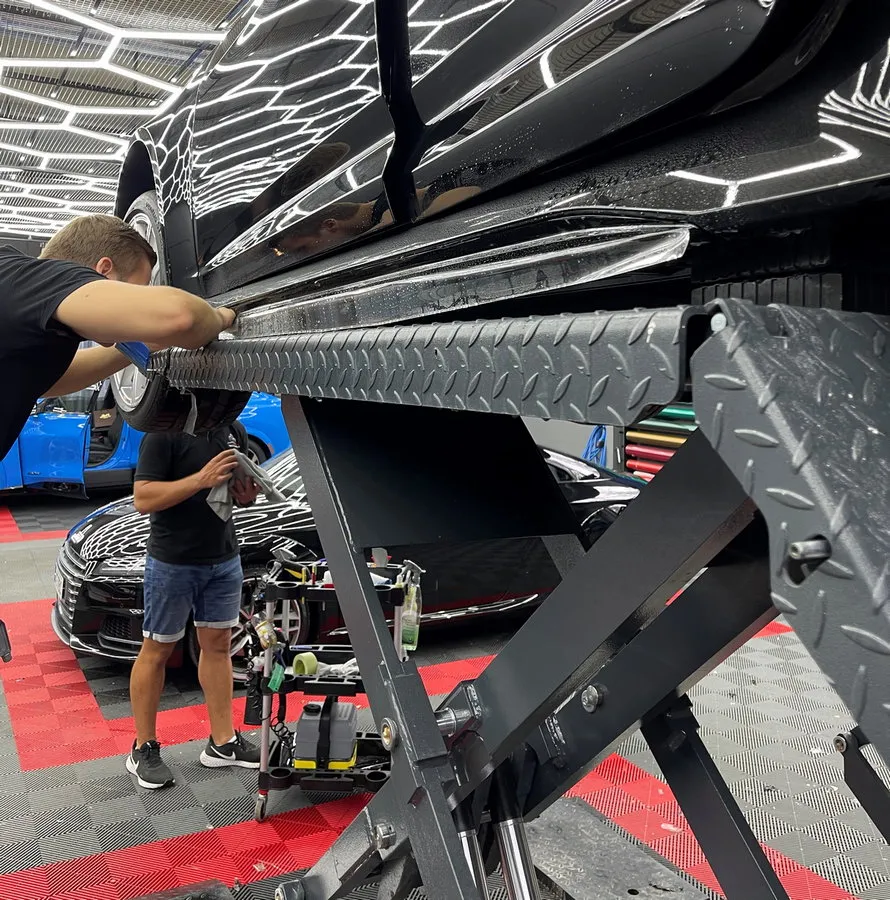
New Car Incoming?
If you’ve ordered a new car and the delivery timeframe is approximately known, it’s advisable to book an appointment for PPF (Paint Protection Film) installation several weeks in advance, especially during the summer, which is the peak season for the wrapping industry.
Often, customers call in and mention they received their car last week and ask if they could get PPF installed. Unfortunately, even with all the flexibility, it’s not always possible to accommodate such requests quickly. Proper scheduling minimizes the number of stone chips. If the delivery date of the car is approximate and the exact delivery date is not known, it’s still better to book an appointment in advance and reschedule later if there are changes from the dealership.
There’s a natural urge to drive and show off the new wheels to friends when you have a new car. Therefore, new car owners should be prepared for patience. Once you get your brand-new car, it’s advisable to drive it immediately to the PPF installation shop because it typically takes around 2+ days, depending on the extent of the protection package. The installed protective film requires a drying time of 1-3 days, depending on the season. In winter, the drying time may be slightly longer, especially during severe cold.
If you don’t have a free slot in your schedule soon, it’s recommended to keep an extra-long safety distance from the vehicles ahead, avoid gravel roads, and generally handle your car delicately until it’s time for the film installation.
It’s also wise to avoid car washes, especially machine washes. This way, you’ll avoid unnecessary scratches on your new car before applying the film. If there are significant and irreparable damages, they will remain visible under the transparent film, which is quite unpleasant.
Ceramic coatings are not recommended before PPF installation. Removing them usually incurs additional costs. Here are more detailed instructions: restyling.fi/en/blog/before-applying-ceramic-coating/

How Much PPF Protection is Worth It?
It’s not always necessary to protect the entire car with PPF, but sometimes it may be the only option.
A carefully considered plan can save your money and your car.
Customers have various lifestyles.
Think in advance about how many tens of thousands of kilometers you drive per year, how many years you plan to keep the car, and consult with a professional shop to find the option that suits your needs and budget.
- Do you have pets or children who might potentially scratch the door sills and rear bumper loading area?
- Do you often use large bags or strollers?
- Do you drive on gravel roads on your daily routes?
- Do you drive more in urban areas or on highways?
- Do you live in an area with many branches and scratching hazards?
Cars come at different price points, and it’s worth considering the experience of wrapping shops. Therefore, the rule of thumb is this:
- Cars costing between €40,000 and €70,000+ should be protected at least from the front and rear wheel arches, door sills, and other vulnerable areas such as the rear bumper corners.
- Cars costing between €100,000 and €140,000+ should be fully protected with PPF, including the window pillars and door sills.
- Cars costing between €160,000 and €200,000+ should be protected not only on the exterior but also on the interior, including the windshield.

If you plan to keep the car for 2 years, it often suffices to protect the hood, front bumper, headlights, and lower body panels.
Depending on the design of the car brand and model and the presence of mud flaps, the lower body panels are particularly vulnerable due to sandblasting-like mechanical stress they endure while the car is in motion. Thousands of stones are propelled by the tires with significant force, causing damage to the thin paint surface.
Mud flaps may not always be helpful because their protection area is limited, sometimes very small. Plus, they don’t always improve the appearance of the car.
Headlights
In recent years, we’ve seen a record number of cracked headlight lenses. The lens material is thin plexiglass, which becomes more vulnerable due to the increased light output. Windshield washer fluid and road salt also contribute to the degradation of the plastic.

A crack in the headlight can lead to moisture entering the light unit, which can damage the electronics inside, ultimately rendering the headlight inoperable. The most expensive LED Matrix headlight unit we’ve seen become irreparable was from a Mercedes AMG version, priced at €2600 per unit (not including the cost of replacing the headlight). For some reason, insurance did not cover this damage, and it could have been avoided with an investment of only €130.
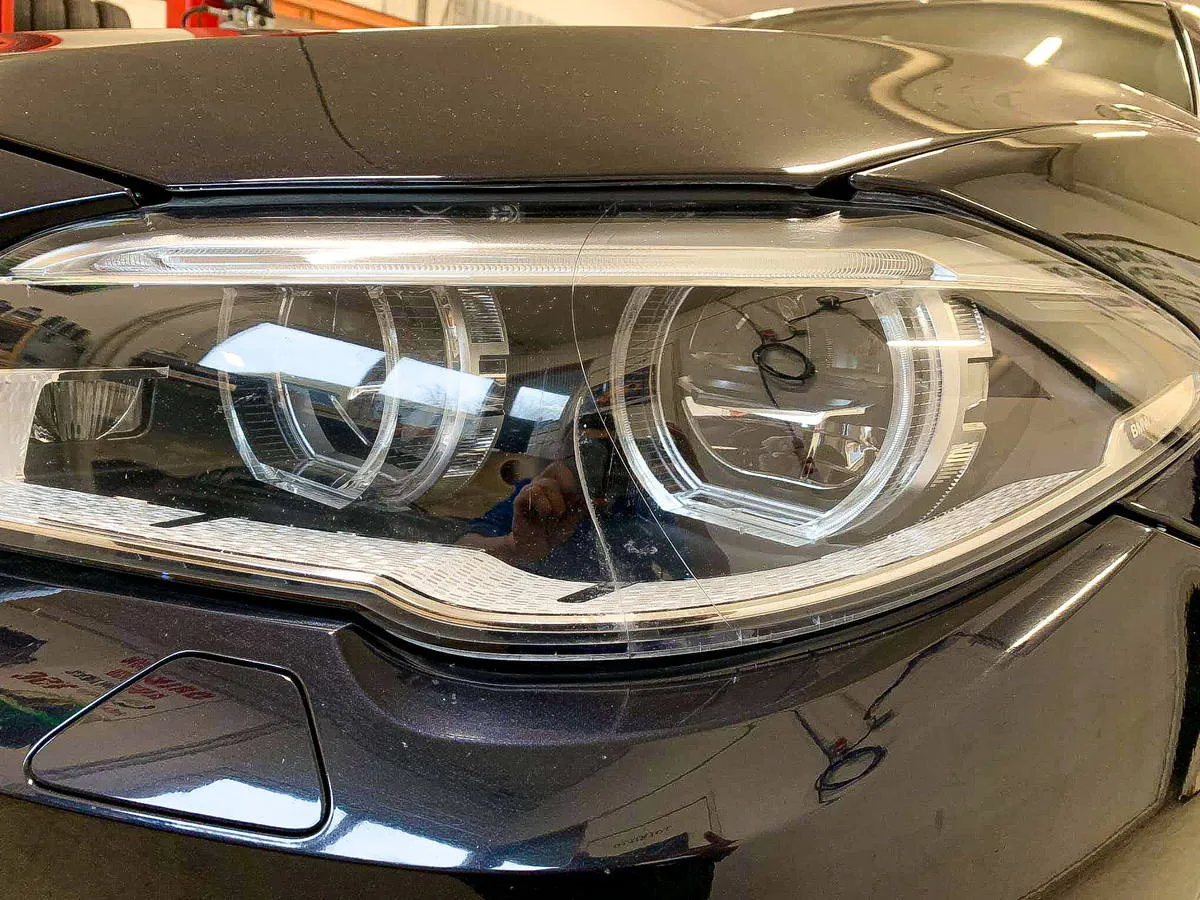
The car owner paid for the headlight replacement themselves and was disappointed that they hadn’t managed to protect the headlight earlier, in other words, “insure it”, with a film.
In some cases of cracks, luck may be on your side, and the film installation seals the crack and prevents further damage to the light. However, in these cases, the crack remains clearly visible under the transparent film, which may not satisfy all owners.
Due to minor stone chips, the headlight surface becomes matte and cloudy, reducing the light output to dangerous levels and often leading to failure during vehicle inspections. Headlights can be wet sanded, which costs hundreds of euros. Unfortunately, after wet sanding, no UV protection helps prevent the same series of events from recurring. Therefore, film is the only proper protection.
If you plan to keep the car for at least 4-5 years, it’s advisable to protect at least the front end of the car: front bumper, hood, front fenders, side mirrors, front part of the roof, front part of the A-pillars, inner sills with skirts, and rear bumper corners.
A professional in car maintenance can interpret the sensitive areas of your car and assist you.
Is It Worth Protecting a Used Car with Film?
Many used cars, even those with over 180,000 km mileage, are protected with PPF paint protection film. Before applying the protective film, additional inspections and stone chip repairs are carried out, sometimes including repainting of separate body parts and checking for the presence of ceramic coatings.
These factors affect the visual outcome of the installed film and its durability. Sometimes, a customer may have a strong desire to protect their car, but the installation shop should act judiciously and assess whether it’s worth installing film on a particular part or not. In such cases, the installation shop usually stops the process and decides not to protect a certain part due to the high number of stone chips it has endured.

Over half of the cars protected with Paint Protection Film have typically been driven an average of 35,000 km or more. Yet, they are still protected because usually, even with these mileage figures, significant damage hasn’t occurred yet.
Can You Install the Film Yourself?
The smallest pieces available for purchase online can be easily installed by yourself. Larger parts, such as the hood and bumpers, can also be done by yourself, but it’s advisable to take wrapping courses, acquire tools and equipment, materials, rental space, and practice on a few cars before doing so. Many car brands sell pre-cut pieces for your car’s front end or rear bumper.
However, not all of these products are of the same quality, and not all installation methods are equally durable. Low-quality films tend to yellow easily, and they may not have self-healing properties or a topcoat chemical protection layer on the film.

For the installation of the film, you need to have a dust-free and warm environment with excellent lighting. You’ll require three different installation solutions and a few mandatory tools and equipment. Even the choice of knife blades is carefully specified to avoid damaging the car’s paint. Rushing is not advisable. Patience and a meticulous mindset are essential for PPF installation. Preparatory cleaning processes are crucial for a successful and, especially, durable wrapping.
It’s often recommended to start small, such as practicing on your phone screen. YouTube is a great resource for learning, as many talented professionals started there.
If you decide to save yourself the hassle, time, and money, a wrapping shop can assist you. When choosing a shop, pay attention to reviews, the materials used, the method of PPF installation, and the overall appearance of the facilities.
For example, does the shop use licensed software with templates, have its own washing area, a sufficiently high lift, trained installers, quality standards, professional tools and drying equipment, and high-quality PPF materials, among other things?
There are significant differences in materials, as well as warranty terms. Ask the wrapping shop to explain these differences and perhaps demonstrate these features.
What to Avoid Before Installing PPF Film?
Due to the correct procedure, the installation of ceramic coatings, underbody rust protection, and potential additional spoilers should be done after the car has been wrapped with protection film.
Spillovers and drips from underbody rust protection can be a significant nuisance before starting the wrapping process. To prevent this from affecting the cost of wrapping, underbody rust protection should be applied after the wrapping process.
The aforementioned processes add additional work during the PPF installation and may potentially increase the cost by hundreds or even thousands of euros.
Insurance Tips
After investing in your car’s resale value, we recommend checking with your insurance company about their policy in the event of your own damage.
Because PPF is a relatively new service and product, not all insurance companies are aware of its true purpose. PPF is not just decorative wrapping but a protective coating against mechanical wear.
The more parts of your car are protected with film, the more reason you have to discuss changes with your insurance company.
We’ve heard from many of our customers that, for example, Pohjantähti includes compensation for self-inflicted damage to protective films. However, this may not always be the case with other insurance companies.
Painting Tips
If you happen to have a traffic accident requiring painting, absolutely do not install film immediately after painting.
Fresh paint needs to adhere and dry for 4-6 weeks after painting. Considering this timeframe during the winter is too short, especially if the car is stored outdoors.
Wait patiently until the drying period is over before installing the films. Additionally, ceramic coatings should not be installed within the drying period. Ceramic coatings also seal the paint, preventing it from “breathing” and drying properly.
If the drying time is not followed, and the film needs to be replaced due to a minor damage, the paint will peel off with the film. This is a very unpleasant consequence that leads to significant costs for repainting the car.
If the damage in a traffic accident is caused by the other party, then of course, the PPF is covered by the compensation.
Do you want the work to be done responsibly, on schedule, and with the best value for your money?
Ask for a quote from Restyling Point’s professionals, who do this with quality standards, values, and love.
WhatsApp: +358445050624
Phone: +358445050624
Email: [email protected]
Restyling Point Ltd – The Nordic leader in wrapping and protection treatments


